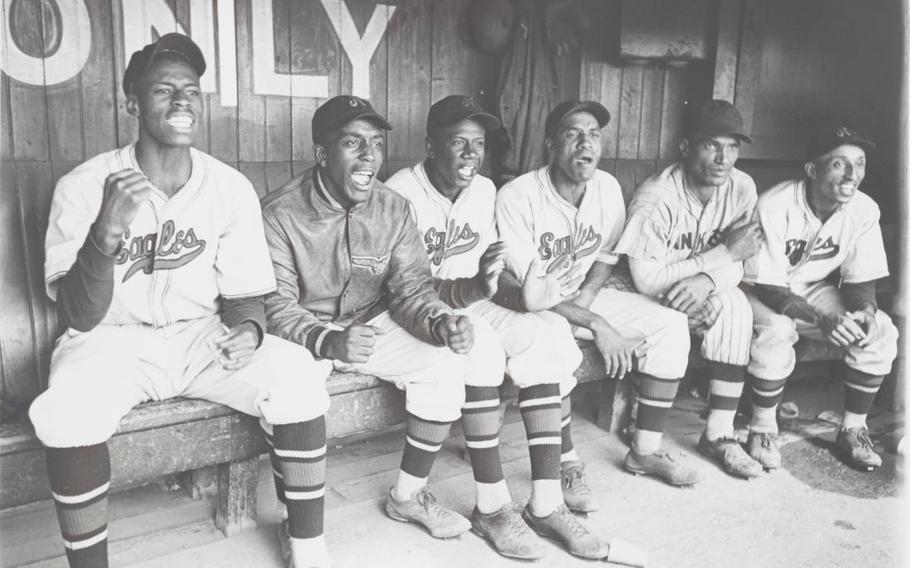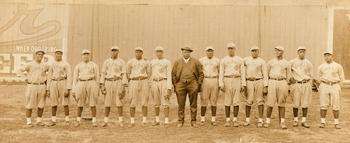
Newark Eagles players in the dugout in 1936. Baseball’s Negro Leagues are the focus of Sam Pollard’s new documentary “The League.” (Courtesy of Magnolia Pictures.)
On Feb. 13, 1920, in Kansas City’s Paseo YMCA, Andrew “Rube” Foster and seven other owners of Black baseball teams across the Midwest established the Negro National League. “We are the ship, all else the sea” — a quote borrowed from abolitionist Frederick Douglass — was adopted as the league’s slogan, and Foster, the owner and manager of the Chicago American Giants, was named its first president.
Foster’s vision for the enterprise, which he had championed since his days as an outstanding pitcher with the Giants from 1911 to 1917, was to create a league so dynamic and entertaining that Major League Baseball’s white owners would be foolish not to expand their more established circuit by joining forces with it. Foster’s premature death at 51 in 1930 denied him the chance to make his dream a reality, but his contributions to the sport and baseball’s eventual full-scale integration are undeniable.
The rise, fall and enduring legacy of the Negro Leagues, none of which would have been possible without the entrepreneurial Foster, is the focus of a new documentary titled “The League” by acclaimed director Sam Pollard. The movie, which opens nationwide this weekend and is executive-produced by Ahmir “Questlove” Thompson, shines a light on the individuals who helped grow the Negro Leagues into a thriving economic force that stabilized Black communities amid the Great Migration. It will be available to stream digitally July 14.
Using newly discovered archival footage, insight from historians and recorded interviews with Negro League players and executives, Pollard traces the history of Black baseball from 1884, when Moses Fleetwood Walker played catcher for the predominantly white Toledo Blue Stockings of the major league American Association, through Jackie Robinson reintegrating the sport in 1947. The movie is based on former Negro League umpire Bob Motley’s memoirs, which were co-authored by his son, Byron, who contacted Pollard about directing the documentary several years ago and recorded many of the interviews featured.
In 1920, the same year the Negro National League was created, Kenesaw Mountain Landis, a federal judge in Chicago, was appointed MLB’s first commissioner. By then, organized baseball had been racially segregated for nearly three decades, due in part to the efforts of legendary Chicago White Stockings player-manager Cap Anson.
In 1887, Anson refused to play an exhibition game against the Newark Little Giants unless the International League team’s Black players, including Walker and pitcher George Stovey, sat out. International League directors held a secret meeting in the wake of Anson’s protest and decided to prohibit the signing of Black players going forward. Other leagues followed suit.
The Negro National League, which featured an up-tempo style of play that would come to define the Negro Leagues, was a success. Foster’s death and the Great Depression brought about the original league’s demise in 1931, but a second Negro National League was founded in 1933 by Pittsburgh businessman Gus Greenlee. Pollard delves into the heated crosstown rivalry that developed between Greenlee’s Pittsburgh Crawfords and Cumberland Posey, owner and manager of the Homestead Grays.
With the founding of the Negro American League in 1937 and stars such as Josh Gibson, Cool Papa Bell, Oscar Charleston and Buck O’Neil dazzling large crowds in multiple leagues across the country, the late 1930s and 1940s marked the heyday of Black baseball.

Rube Foster while managing the 1916 Chicago American Giants. Foster was the first president of the Negro National League, one of the several Negro Leagues that are the focus of Sam Pollard’s new documentary “The League.” (Courtesy of Magnolia Pictures.)
Meanwhile, Landis did little to change the status quo at the major league level, which remained segregated despite no official policy against signing Black players.
“This was a period of American history where Jim Crow and the rule of segregation was the law of the land, and it was very difficult for people to see Black people being integrated in anything that involved the so-called American experience,” Pollard said.
In one of the more revealing parts of “The League,” Pollard details the role that Wendell Smith of the Pittsburgh Courier and other Black sportswriters had in integrating baseball. In December 1943, Paul Robeson, the Black singer, actor and civil rights activist, made the case for integration during a roughly 10-minute presentation to Landis and MLB’s 16 owners during a meeting attended by several prominent Black newspapermen.
Landis died in office in November 1944. The following year, Brooklyn Dodgers president Branch Rickey signed Robinson of the Negro League Kansas City Monarchs to a minor league contract. One aspect that is typically left out of the oft-told story of Rickey’s and Robinson’s roles in integrating baseball, but which receives ample attention in “The League,” is Rickey’s low opinion of the Negro Leagues and the detrimental effects Robinson’s signing had on the future of Black baseball.
“Integration was good morally and socially ... but that progress came at a cost,” Bob Kendrick, president of the Negro Leagues Baseball Museum in Kansas City, says in the movie.
Rickey mocked the idea of compensating teams from which he poached stars such as Robinson, Don Newcombe and Roy Campanella, drawing criticism from Effa Manley, longtime owner of the second Negro National League’s Newark Eagles. Without some of its biggest stars, the Negro National League folded in 1948.
As Manley, who died in 1981 and is the only woman inducted in the Baseball Hall of Fame, put it: “Fans deserted us to go see the boys on the White team.”
“The League” is the latest — and most thorough — recognition of the Negro Leagues in recent years.
In December 2020, MLB announced it would add the names and statistics of more than 3,000 Negro Leaguers from seven distinct leagues in the 1920s, 1930s and 1940s to its official records. The latest edition of “MLB The Show,” baseball’s most popular video game simulation, includes eight Negro League legends as part of a new game mode, with narrative videos about their journeys. Just last month, MLB announced the St. Louis Cardinals and San Francisco Giants will play a regular season game in 2024 at Rickwood Field in Birmingham, Ala., which was home to the Negro Leagues’ Birmingham Black Barons.
“I think that’s fantastic,” said Pollard, who grew up a Cardinals fan and is plenty familiar with historic Rickwood Field. It is where he shot beautiful re-creations with local college players in period-specific uniforms and equipment to break up the monotony of black and white archival footage and on-camera interviews in the movie. “The thing they complained most about was those old gloves.”